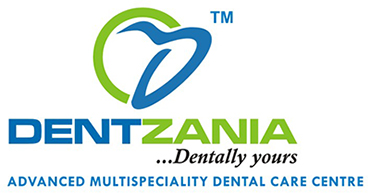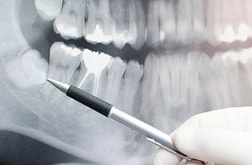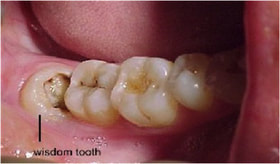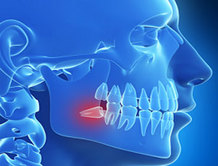MAXILLOFACIAL SURGERY / TOOTH EXTRACTIONS
Tooth Extractions
One of the primary treatment goals in dentistry is to preserve teeth. Even the most advanced and lifelike prosthetic replacement can’t compare to a natural tooth for function, health and appearance.
There are times, however, when extracting a tooth might be in your best long-term health interest. If that happens there are effective methods to remove the tooth safely and efficiently, and with minimal discomfort.
Reasons to Extract a Tooth
Sometimes a tooth must be extracted because it is no longer healthy enough to function effectively, or it poses a danger to other teeth or your overall dental health. In some cases, the tooth has decayed too greatly to remain vital, or the gum tissues that hold it in place have detached because of progressive periodontal (gum) disease. In other cases, the tooth’s long-term health has been compromised by traumatic injury.
A tooth may need to be removed because it endangers other teeth or interferes with jaw and bite function. For example, third molars—wisdom teeth—are prone to impaction, a condition in which the crown doesn’t emerge fully from the gums during eruption. Often in an abnormal position below the gums, an impacted wisdom tooth can press against the roots of adjacent teeth, damaging them. For this reason and their high susceptibility to gum disease, impacted wisdom teeth are often extracted to reduce current or future problems.
A dentist may also extract an otherwise healthy tooth to improve the success of orthodontic treatment. Misaligned teeth are moved into better positions with braces or similar orthodontic appliances; sometimes, though, there may be little to no movement space because of tooth crowding. A dentist may remove certain teeth to create this necessary space. The teeth most frequently extracted for this purpose are the first bicuspids (located behind the eyeteeth near the front of the mouth). Removing these teeth won’t result in a loss of function and the ensuing orthodontic treatment will create a cosmetically satisfying result.
TOOTH EXTRACTIONS AT DENTZANIA …
The extraction method used will depend on the type and location of the tooth, and whether any extenuating circumstances exist that could complicate its removal.
Before any extraction procedure, we will perform a proper assessment and diagnosis of the tooth including its position in the mouth and any possible removal complications. This assessment will include recent x-rays and a complete medical history, including current prescription drugs that might interact with any anesthesia.
While some people are apprehensive about having a tooth removed, modern extraction techniques aided by anesthesia are pain-free with only mild to moderate discomfort for a few days after the procedure. In many cases, teeth with a straightforward removal path can be extracted with a minimally invasive technique known as simple extraction.
Teeth are held in place by the periodontal ligament, an elastic gum tissue that attaches to the teeth on one side with tiny fibers and to the jawbone on the other side in similar fashion.
SIMPLE EXTRACTIONS :
Simple extractions are performed on teeth that are visible in the mouth, usually under local anaesthetic, and require only the use of instruments to elevate and/or grasp the visible portion of the tooth. Typically the tooth is lifted using an elevator, and using dental forceps, rocked back and forth until the periodontal ligament has been sufficiently broken and the supporting alveolar bone has been adequately widened to make the tooth loose enough to remove. Typically, when teeth are removed with forceps, slow, steady pressure is applied with controlled force.
SURGICAL EXTRACTIONS :
involve the removal of teeth that cannot be easily accessed, either because they have broken under the gum line or because they have not erupted fully. Surgical extractions almost always require an incision. In a surgical extraction the doctor may elevate the soft tissues covering the tooth and bone and may also remove some of the overlying and/or surrounding jawbone
WE AT DENTZANIA ASSURE YOU SPECIALITY TREATMENT BY EXPERTS AND MINIMAL DISCOMFORT EVEN IN COMPLEX SITUATIONS
WISDOM TOOTH IMPACTION SURGERY :
Formally known as third molars, wisdom teeth are located at the very back of the mouth on either side of both upper and lower dental arches (jaws). They are typically the last permanent teeth to appear (erupt) between the ages of 17-25. Most people have four wisdom teeth, although some may have more, fewer or, in rare cases, none at all.
Their late eruption is the primary reason wisdom teeth are prone to problems with coming in properly. They’re notorious for erupting at skewed angles or becoming impacted, a condition in which the tooth does not fully erupt but remains fully or partially submerged below the gum line.
One of the primary treatment goals in dentistry is to preserve teeth. Even the most advanced and lifelike prosthetic replacement can’t compare to a natural tooth for function, health and appearance.
There are times, however, when extracting a tooth might be in your best long-term health interest. If that happens there are effective methods to remove the tooth safely and efficiently, and with minimal discomfort.
Reasons to Extract a Tooth
Sometimes a tooth must be extracted because it is no longer healthy enough to function effectively, or it poses a danger to other teeth or your overall dental health. In some cases, the tooth has decayed too greatly to remain vital, or the gum tissues that hold it in place have detached because of progressive periodontal (gum) disease. In other cases, the tooth’s long-term health has been compromised by traumatic injury.
A tooth may need to be removed because it endangers other teeth or interferes with jaw and bite function. For example, third molars—wisdom teeth—are prone to impaction, a condition in which the crown doesn’t emerge fully from the gums during eruption. Often in an abnormal position below the gums, an impacted wisdom tooth can press against the roots of adjacent teeth, damaging them. For this reason and their high susceptibility to gum disease, impacted wisdom teeth are often extracted to reduce current or future problems.
A dentist may also extract an otherwise healthy tooth to improve the success of orthodontic treatment. Misaligned teeth are moved into better positions with braces or similar orthodontic appliances; sometimes, though, there may be little to no movement space because of tooth crowding. A dentist may remove certain teeth to create this necessary space. The teeth most frequently extracted for this purpose are the first bicuspids (located behind the eyeteeth near the front of the mouth). Removing these teeth won’t result in a loss of function and the ensuing orthodontic treatment will create a cosmetically satisfying result.
TOOTH EXTRACTIONS AT DENTZANIA …
The extraction method used will depend on the type and location of the tooth, and whether any extenuating circumstances exist that could complicate its removal.
Before any extraction procedure, we will perform a proper assessment and diagnosis of the tooth including its position in the mouth and any possible removal complications. This assessment will include recent x-rays and a complete medical history, including current prescription drugs that might interact with any anesthesia.
While some people are apprehensive about having a tooth removed, modern extraction techniques aided by anesthesia are pain-free with only mild to moderate discomfort for a few days after the procedure. In many cases, teeth with a straightforward removal path can be extracted with a minimally invasive technique known as simple extraction.
Teeth are held in place by the periodontal ligament, an elastic gum tissue that attaches to the teeth on one side with tiny fibers and to the jawbone on the other side in similar fashion.
SIMPLE EXTRACTIONS :
Simple extractions are performed on teeth that are visible in the mouth, usually under local anaesthetic, and require only the use of instruments to elevate and/or grasp the visible portion of the tooth. Typically the tooth is lifted using an elevator, and using dental forceps, rocked back and forth until the periodontal ligament has been sufficiently broken and the supporting alveolar bone has been adequately widened to make the tooth loose enough to remove. Typically, when teeth are removed with forceps, slow, steady pressure is applied with controlled force.
SURGICAL EXTRACTIONS :
involve the removal of teeth that cannot be easily accessed, either because they have broken under the gum line or because they have not erupted fully. Surgical extractions almost always require an incision. In a surgical extraction the doctor may elevate the soft tissues covering the tooth and bone and may also remove some of the overlying and/or surrounding jawbone
WE AT DENTZANIA ASSURE YOU SPECIALITY TREATMENT BY EXPERTS AND MINIMAL DISCOMFORT EVEN IN COMPLEX SITUATIONS
WISDOM TOOTH IMPACTION SURGERY :
Formally known as third molars, wisdom teeth are located at the very back of the mouth on either side of both upper and lower dental arches (jaws). They are typically the last permanent teeth to appear (erupt) between the ages of 17-25. Most people have four wisdom teeth, although some may have more, fewer or, in rare cases, none at all.
Their late eruption is the primary reason wisdom teeth are prone to problems with coming in properly. They’re notorious for erupting at skewed angles or becoming impacted, a condition in which the tooth does not fully erupt but remains fully or partially submerged below the gum line.
Space seems to be the main factor in eruption abnormalities: Because most of the other teeth have already erupted, there may be little available room for a normal eruption of wisdom teeth. Smaller-than-normal jaws may also restrict available space.
While an impacted wisdom tooth may not display any pain symptoms (a person may not even be aware of it), it could still wreak havoc below the surface. The abnormally positioned tooth presses on other structures—like neighboring second molar teeth, gums, or nerves—potentially affecting their health and disrupting their function. This commonly results in periodontal (gum) disease with loss of bone around the second molars because cleaning the area between the impacted tooth and its neighbor becomes very difficult—for both the patient and the dental hygienist. The inability to remove bacteria and tartar from this area could endanger the long-term survival of these teeth.
When the impacted tooth erupts only partially, this can lead to pericoronitis—a painful, acute infection that develops around it. Pericoronitis is usually treated by gently irrigating the tissues to remove bacteria and other debris, and the pain managed with anti-inflammatory drugs like ibuprofen and antibiotics. Because it can be a recurring problem, the best recourse may be to eventually remove the partially impacted tooth.
While an impacted wisdom tooth may not display any pain symptoms (a person may not even be aware of it), it could still wreak havoc below the surface. The abnormally positioned tooth presses on other structures—like neighboring second molar teeth, gums, or nerves—potentially affecting their health and disrupting their function. This commonly results in periodontal (gum) disease with loss of bone around the second molars because cleaning the area between the impacted tooth and its neighbor becomes very difficult—for both the patient and the dental hygienist. The inability to remove bacteria and tartar from this area could endanger the long-term survival of these teeth.
When the impacted tooth erupts only partially, this can lead to pericoronitis—a painful, acute infection that develops around it. Pericoronitis is usually treated by gently irrigating the tissues to remove bacteria and other debris, and the pain managed with anti-inflammatory drugs like ibuprofen and antibiotics. Because it can be a recurring problem, the best recourse may be to eventually remove the partially impacted tooth.



